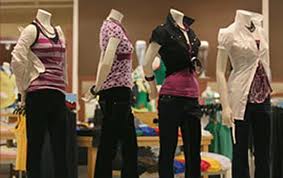SCOPE OF FASHION MERCHANDISING IN GARMENT INDUSTRY IN BANGLADESH
Introduction:
Garment is now the largest export earner in Bangladesh. Bangladeshi garments ware increasingly becoming visible in the market of developing countries. Bangladesh is one of the leading readymade garments exporters of the world. Every year Bangladesh exports more than one third of the total garments requirements of the RMG market of the world. Every year Bangladesh earns more than 76% of its foreign currency from this sector. For the high progress in the sector efficient fashion merchandising is essential, which included proper dealing to buyer, high quality production, proper shipment on due date etc. Fashion merchandising is therefore plays a very important role in the garments factory and other industries to ensure the quality and other competitive requirement to survive in the market. It is very necessary to have very good merchandiser in the industry to survive in the market, to run a factory successfully in this competitive market.
The “Fashion merchandiser” profession has recently emerged as one of the most sorts out careers among the fashion designer. The designers have their own creative style of dressing and believe in setting a trend rather than following a trend set by other. A career in fashion design not only involves meeting glamorous people and interacting with rich and famous but also gives a impetus to the creative flair of the people who possess a sense of style. The major functional areas in the industry are dressing garments, cutting the cloth, sewing the pieces together and finally merchandising popularizing and marketing of the various style and products done through ramp show and fashion write-ups.
Fashion merchandising is the promotion of apparel sales and involves all of the tanks necessary to deliver the clothing requests and meet the needs of potential customers and advertisements, directing, manufacturing and marketing and creating sales strategies are all part of the job. Fashion merchandising also refers to the necessary preparation that must be done in order to ensure that the merchandise is accessible and appealing to the customers it’s intended for.
Fashion merchandiser has responsibility to design and create visually attractive displays or exhibits of merchandise and to erect main store decoration in commercial retail establishments. They create the look, feel and mood of the store.
Bangladesh has recently come to the focus. Along with the world demand the local market is also altering itself to rapid changes in fashion trends. Bangladesh’s largest sector garments/textiles is recently looking for Fashion merchandiser and highly skilled technical personnel.
Aim:
To explore the value of Fashion merchandising in apparel industry.
To explore the policies and improve the Fashion merchandising in the department of merchandising of apparel industry.
To achieve the goal of popularity as a profession of Fashion merchandising in Bangladesh.
To spread the Fashion merchandising task in Bangladesh.
Objectives:
To the role of Fashion merchandising in garments sector.
To get idea of Fashion merchandising as a profession.
To get some idea on present status of Fashion merchandising job.
To know about the importance of Fashion merchandising in apparel industry
To have clear concept on the proper execution of a garment order and its relative works.
To expose all the variation of Fashion merchandising.
Methodology:
Literature review
Study of books, journal of Fashion merchandising
Discussion with teacher’s and friends.
Browsing internet
Industry visit\
Buying house visit.
Scope:
Field work
Market study
Documentation
Library work
Discussion with managers of apparel factory
Existing Fashion merchandisers of industry
Limitation
Time is not enough for doing this job
Don’t get enough information from apparel industry
Complicated to visit buyer’s house and apparel industry
Didn’t get enough information from books and internet
Superior person of the industry don’t have enough time to give information
Literature Review
Bangladesh Fashion Designer(Fashion Merchandiser) in International Market
Fashion design is the applied art dedicated to the design of clothing and lifestyle accessories created within the cultural and social fabrics in a given time. Fashion design differs from costume design due to its core product having a built-in obsolescence. A season is defined as either autumn/winter or spring/summer. A Fashion designer should be artistic and creative. They should be able to express their ideas in sketches. They may not be brilliant artists but are able to combine colors, shades, and tones. Designers have the flair and knowledge for creating fabric and using textiles effectively. Designers need to have visual imagination and the ability to think in three dimensions.
Bangladesh is proud to have a variety of handmade crafts like Jamdani, Rajshahi silk, Reshmi silk. Perhaps, the most famous yarn from this part of the subcontinent is Dhaka Muslin, a superfine silk yarn embellished with intricate hand embroidery. But it is a big question now whether the brand exists in the market. While talking to the Cotton Bangladesh designers, garments exporters of Bangladesh say, “We do have Brand Bangladesh, but the specialty of Brand Bangladesh for the most part, truly our own. We weren’t able to put up that sort of exposure for international market.” Most of the designers of Bangladesh runs their own boutiques and produces not only for a local clientele but have participated in various international fashion events. But the fashion design of Bangladesh is struggling to strengthen its position in the international market. In this literature, we will try to figure out the reasons of market challenges of Bangladeshi fashion design and put together the recommendations of experts to overcome this cataclysm.
The general problem in Bangladeshi textile production is the small number of available fashion designers. It is difficult to know how many there are, as there is no organization for fashion designers. The lack of fashion designers also means that whenever a designer, trained in-house, moves to new place leaving the former with no expert hand In “The buyer model,” the buyer brings materials and designs, often the patterns, to the producer. The producers learn how to make one particular design; but they neither learn anything about the market research and trend analysis underlie the design nor the actual act of designing and the design management process.
The international trade of textiles is highly competitive. Skill, design and quality are essential. But, equally important is the need to assess national and international demands and integrate them into the production process. There is no doubt that very few of the Bangladeshi designers know the international markets. There is a unison cry in Bangladesh saying that they need help from foreign designers to make their products marketable internationally. This is even more the case if the products are going to be developed into high-value niche products.
It is a good sign for Bangladesh that The Fashion Designing profession has recently emerged as one of the most demandable careers among the youth. These young folks have their own creative style of dressing and belief in setting a trend rather than following a trend set by others. A career in fashion design not only involves meeting glamorous people and interacting with rich and famous but also gives an impetus to the creative flair of the people who possess a sense of style. But still Bangladesh is struggling to establish a standard in fashion design for international market.
There are several findings, which will explain the reasons why Bangladesh is struggling in international market with their fashion design.
There is Large number of qualified product designers available in RMG sector. “qualified” designers having experience with product design learn through trial and error and provide the
The list mentioned is not exhaustive but does show some of the crucial points, which can be put to good effect in the context of businesses in countries like Bangladesh. Certain resources, however, are required in order to encourage these kinds of practices, most notably the trained designers who are able to manage design. This use of design as a resource in business is a long way off in Bangladesh. Many say that to be a full-pledged professional designer, it is necessary to knock the door of Design Institutes. A good institute will ensure that along with the requisite theoretical inputs. A person will get adequate practical exposure to the entire gamut of processes right from the formation of textiles and fabrics to the most elaborate design elements.
Several institutes like BIFT, Shanto-Mariam University of Creative technology, National Institute of Fashion Design, Pearl Fashion Institute, Design and Technology Center, Lankan institute of fashion & technology have started giving training of several kinds, like merchandising, knitwear Design & Technology, apparel manufacturing, marketing and merchandizing. Exporters say that these institutions are not only very young but also very weak. There are many warning voices being heard in Bangladesh as far as cooperating with “non-established” institutions that may be too weak to survive. On the other hand, the weaknesses also make a need for support very obvious. But the academics are claiming that the exporters are not cooperating with the institutions by providing internship options for the upcoming designers from the institutes. The students from these institutes are blaming the exporters for not providing sufficient job opportunities for them. The upcoming designers think that media can play an active role in this sector. There is a large gap between the needs of the textile and clothing industry and the supply of graduates, be it in textile technology and/or in design. It should also be mentioned that no institution in Bangladesh offers master’s level education or the opportunity of M Phil or PhD research works in the field. Experts think that the teachers from these institutes need further education, either through higher education abroad or entering internships in (fashion) companies. As far as student exchange programs can be developed, this would most probably have positive effects both in industry and in the partner design institutions.
The future of the Bangladeshi textile production lies in the development of high-value-added products, suitable for long-term export markets and for the local market in short-term. In order to develop such products, Bangladesh needs strengthening of its design potential. This should mainly be done through training Bangladeshi designers with the help of the foreign designers. This way, product development and training in the workplace will be combined, giving both short term and longer-term effects. This is a large sector; supporting the newly established schools through training the designers for this industry should be considered as important investment for market sustainability.
Nature of Work of Fashion Merchandiser
Fashion merchandisers purchase materials required for production, price the finished garments and liaise between the production line and the marketing of finished garments. The job involves an understanding of market demand and coordination of the production process.hey are to a large extent responsible for setting fashion trends or perhaps analyzing trends. The weaving of fabrics is carried on based on the advance orders of merchandisers.
Merchandising
The merchandiser’s work is one of coordination. The job can be broken down into the several functions. Merchandisers understand buying trends and the buyer’s needs. They collect specifications from buyers, prepare samples approved by the buyer, they price the samples. From procurement of raw materials to production management it is the responsibility of merchandisers. They oversee quality and ensure timely delivery to the buyers.
Merchandising can be divided into the following stages
Product development
Merchandisers along with fashion designers develop a product which is market specific. In export houses merchandisers gear the company’s production line to meet customer requirements. Merchandisers require specifications/measurements from buyers to translate the sample requirements to fashion designers first and then to the production team.
Sampling stage –
Merchandisers give buyers samples for their opinion and advise. On approval, costs are negotiated. Modifications to the sample may be suggested.
Production stage –
Raw materials are procured by the merchandising department, quality check is carried out for proper materials supply and finally the production process is monitored. On line inspection has to be carried out to ensure specifications of the buyers are met. Final approval is given by the buyer on the on-line inspection after which garments are packaged and dispatched to the buyers.
Visual merchandising –
Visual merchandisers are engaged as managers for shop floor/window decorations. Window display has become an impressive marketing strategy. A person on the move may spend just seven seconds to glance at a shop window. Visual merchandisers are trained for making the display very impressionable.
The concept of window dressing has proved to be extremely popular with hauteur couture shopping outlets, high fashion boutiques, emporiums etc. Exhibitions, fairs, shopping stores are places where window and floor displays are very popular. Visual merchandisers get paid for the contract and the amount varies according to their image in the industry.
Work Environment
Merchandisers have to work through meetings in offices, during production in the factory and go through substantial travelling while analysing fashion trends, selecting raw material and while dispatching goods to buyers. The job environment varies with the size of the industry and may involve considerable travel, both domestic and international.
Personal Characteristics
The job requires interest in fashion, a close eye for detail, awareness of cultures and fashion through ages. Merchandisers need to work as part of a team hence team spirit is important. Communication and interaction skills are essential to the job. The work is stressful particularly when deadlines have to be met.
Merchandisers have tremendous responsibilities hence they have to be completely involved in the production process. Often the success of the firm is attributed to the merchandising efficiency.
Employment Avenues
Merchandisers work in domestic or export garment industries. In large manufacturing firms/export houses merchandisers specialize as production managers, quality controllers, fashion retailers, export managers etc. Visual merchandisers work as shop floor and shop window decorators.
Fashion Merchandiser Job Responsibilities
A Fashion Merchandiser has the responsibility to design and create visually attractive displays or exhibits of merchandise and to erect main store decorations in commercial retail establishments. They create the look, feel and mood of the store.
They attract the attention of consumer and finally make them purchase the merchandise. They analyze sales tracks and trends for success of the store promotions.
- Plan and design commercial merchandise displays, make use of space, colour, products, lighting and accessories to decorate the interiors and windows of the retail shops.
- Create the ambiance of a store for the pleasant experience of a customer.
- Sketch the design ideas on computer or by hand.
- Find and create props that could be used in displays.
- Arrange for lighting.
- Arrange table displays.
- Dress mannequins.
- Create and hang decorations.
- Design and create signs.
- Work with marketing and management to make sure that the displays are matching with the marketing and image of the store.
- Consult with sales and advertising.
- Order merchandise.
- Stock departments and displays with inventory.
- Price and tag products.
- Work with retail management to implement and establish financial objectives.
- Monitor customer feedback.
- Analyze sales trends to assess their effectiveness
Role of a Fashion Merchandiser
Contributing Writer
This article was created by a professional writer and edited by experienced copy editors, both qualified members of the Demand Media Studios community. All articles go through an editorial process that includes subject matter guidelines, plagiarism review, fact-checking, and other steps in an effort to provide reliable information.
A fashion merchandiser (also referred to as a buyer or merchant) plays an important role in any retail organization. A merchandiser occupies both creative and financial roles. Although different companies may assign different types of responsibilities to a merchandiser, certain components are part of a fashion merchandiser’s job, no matter the size of company or type of fashion product bought.
A fashion merchandiser is responsible for selecting the merchandise that will sell in stores. This merchandise must be in alignment with the company’s brand image. The merchant must choose trend-right merchandise that is also appropriate for the target customer’s fashion level. This requires knowledge of current and future fashion trends — both high-fashion from the runway and mass-market trends.
Financial Accountability
Meeting financial objectives is the primary component of a fashion merchandiser’s job. The merchandiser must maintain profitability by meeting certain financial plans set for each season. All merchandise bought must be appropriate for the customer and offered at a reasonable yet profitable price. A merchandiser’s performance review will be partially based on the profit margin reached, rates of merchandise turnover and sales volume.
Customer Knowledge
In order to offer an appealing assortment, a merchant must be intimately familiar with the needs and wants of the target customer. This is accomplished by spending time in stores, even working full shifts in them. A merchandiser should research fashion trends, read trade newspapers, and follow the semi-annual runway shows. A merchandiser should also spend time in competitors’ stores, study other retailers’ merchandise and track when they deliver new assortments.
Visual Merchandising
Visual merchandising refers to the display of items in stores, including signage and marketing materials. When buying goods, a merchandiser must always think of how items will be shown. This involves determining which types of fixtures and folding methods will be necessary to properly house merchandise. Visual merchandising is important because sales can be negatively affected if items are not displayed correctly.
Administration
Administrative work isn’t the most exciting of tasks that a merchandiser must perform, but it is essential. A great deal of paperwork is necessary to take a product from its initial concept to arrival in the store. A buyer may file buy sheets, purchase orders, price ticket info and marketing materials. All must be completed with an extreme attention to detail.
Data collection and Research Methodology
Data Presentation
Table No1. Job responsibility of a Fashion Merchandiser
| Job responsibility | Frequency | Percentage% |
| Management | 3 | 30% |
| Design Development | 6 | 60% |
| Communication | 1 | 10% |
N.B: Number of sample 10 person
Table No.2.Deaign Creation for production
| Job responsibility | Frequency | Percentage% |
| Yes | 1.5 | 15% |
| No | 8.5 | 85% |
N.B: Number of sample 10 person
Table No.3. Involvement in product development process
| Job responsibility | Frequency | Percentage% |
| Yes | 9.5 | 95% |
| No | 0.5 | 5% |
N.B: Number of sample 10 person
Table No.4. Involvement in Garments Manufacturing process
| Job responsibility | Frequency | Percentage% |
| Yes | 9.5 | 95% |
| No | 9.5 | 5% |
N.B: Number of sample 10 person
Table No.5.Communicating with buyers
| Communication skill | Frequency | Percentage% |
| Yes | 9 | 90% |
| No | 1 | 10% |
N.B: Number of sample 10 person
Table No.6.Top post a Fashion Merchandiser
| Achievement Top post | Frequency | Percentage% |
| J.R Mechandiser | 0.2 | 2% |
| S.R Merchandiser | 2.8 | 28% |
| Manager/Director | 7 | 70% |
N.B: Number of sample 10 person
Table No.7.Fashion merchandising available in RMG Sector
| Availability in RMG sector | Frequency | Percentage% |
| Available | 7 | 70% |
| Very available | 2 | 20% |
| Not available | 1 | 10% |
N.B: Number of sample 10 Person
Table No.8.future of a Fashion Merchandising in Bangladesh
| Prospectus of Fashion Merchandising | Frequency | Percentage% |
| Good | 3 | 30% |
| Bright | 5 | 50% |
| Very bright | 2 | 20% |
N.B: Number of sample 10 person
Table No.9.Fashion Designer become a Fashion Merchandiser
| Provability of fashion merchandiser | Frequency | Percentage% |
| Yes | 9 | 90% |
| No | 1 | 10% |
N.B: Number of sample 10 person
Table No.10.Merchandiser cannot be a Fashion Merchandiser.
| Provability of merchandiser | Frequency | Percentage% |
| Yes | 9 | 90% |
| No | 1 | 10% |
N.B: Number of sample 10 person
Results and Discussion
The Fashion as one of the most sort out careers among the youths These youths have their own creative style of dressing and believe in setting a trend rather than following a t.5rend set by others. A career in Fashion Merchandising not only involves to the creative flair of the people who possess a sense of style ,he or she need a sound academic qualification. The major functional areas in the industry are designing garments, . merchandising and finally marketing of the various styles and products .
The job of a fashion Merchandising is a high profile one and exciting indeed. But another aspect of this profession is a lot of hard work that is needed to be able to reach the top of this line and stay there. It is certainly not as easy as it sounds. In our garments sector fashion merchandiser do not design any product but they are involved in product development. They also directly involve in Garments manufacturing process.
Fashion is a term commonly used in relation to clothes, dresses, garments, textiles, etc. There is an increase in quality textiles and materials for the fashion Merchandiser communicate with designers & buyers. Fashion merchandiser is identified today with status, acceptance and it almost implies social involvement.
Bangladesh has recently come to the focus. Along with the world demand, the local market is also altering itself to rapid changes in fashion trends . Bangladesh’s largest sector Garments/Textiles is recently looking for Fashion merchandiser and Highly skilled technical Personnel. A Fashion merchandiser start the career as a junior merchandiser finally he or she becomes a manager or director.
Fashion merchandiser of Bangladesh also has the opportunity to work with the world class buyer .world class buyer often accept design our Fashion merchandiser design. So our garments sector recently develop Design Department which is called Design studio. Manufacturing units work on a large scale. They employ designers, junior designers, Fashion merchandiser and garment constructor. Sketching assistants make the technical sketches ring process specification drawings decide how a garment has to be fabricated to the selection of fabrics is often the duty of the sketching assistant. Junior designers generally do the first pattern cutting. They assemble the first samples with fabrics they have selected from the market. Then Fashion merchandiser place it for international buyers. Sometime they modify the design, then fashion merchandiser again communicate with design department & develop the design.
Fashion trends are constantly changing; the people in the merchandising and marketing have a good knowledge of fashion trends, of sales data and the organizations marketing objectives. Based on this information the marketing department plans the company’s overall direction. It determines the price, product requirement, and hence they often work with the styling department when a new product id conceived.
The production manager is also a Fashion merchandiser who is at the head of the manufacturing unit. He is responsible for scheduling work goals, training of workers, managing all activities in order to maintain quality in production. The Production manager oversees the work of pattern cutting – from pattern grading, spreading and marking for cutting, assembling and finishing. With the production manager are the production assistants who supervise the work at each stage. They coordinate with the buyer and the production manager. The fashion coordinator makes sure production schedules are kept, meets buyers goes through specification for fabrics, colours, designs, and keeps an eye on the quality. When buyers give their own designs, the coordinator helps decide the fabric colours and accessories that should be used to suit the designs. They explain the design to the production pattern makers and get sample pieces made. The sample is draped on a dummy to see if some changes in details or style are required. Once the sample is finalized, its pieces are measured precisely. It is the coordinator who suggests how the cloth should be cut so as to minimize wastage. The garment is then finally presented for sale.
Overall Conclusions
Fashion Merchandising is the applied art devoted to the designing of clothing and lifestyle . This art is influenced by cultural and social attitudes and has evolved over time and place. Fashion Merchandising one of the most lucrative, appealing, glamorous and exciting career options in today’s world. If you have a penchant for creativity, style and originality, a career in Fashion Merchandising is the one tailor made for you. On one hand, the fashion industry satisfies both the creative fancies and the materialistic needs of the people. On the other hand, it promises glamour, fame, success and a high pay package to the talented people.
However, it is also a demanding career, as fashion Merchandising need to combine their creativity with managerial skills to sustain in this industry. Our garments sector & textile sector give job facility new generation, who complete their academic career from Fashion Design .Because of Fashion Merchandiser are eyeing to fulfill a target to export garments worth $30 billion within the next three years, against a backdrop of current trends. They handle production, marketing, merchandising, productivity issues, designing and buyer negotiations.
At present, the country lacks the institutes to produce a sufficient number of such technical people, with only a few graduates coming out to fill the posts of Fashion merchandisers.
We have no problem with orders, but we need to address the issues of skilled workers .I doubt the ability to achieve the $30 billion export mark in the next three years with the present strength of the workforce, although growth will take place for the orders that are coming in at an increased rate from the international buyers.
Future Recommendation
Fashion merchandising is an integral part of the fashion industry because this dictates how the retail fashion sector of the industry moves. A fashion merchandiser will be the one to take on the responsibility of conceptualizing strategies on how best to sell clothes, what kind of clothes to buy, where to place them strategically to attract customers, research on the market trending, and even visualize the retail display to lure people into going inside the store and checking out the merchandise. While having a good sense of fashion style and understanding it better than everyone else is already a talent in itself, you will never be well-equipped enough to handle everything in the fashion world if you don’t go to school to learn more about it Fashion merchandisers are paid a lot because they have a lot of responsibilities, and as such, the best way to be as informed about it before going into the fashion world full throttle is to learn as much as you can.
- Academic Background:To be a fashion Merchandiser at first need field related education & knowledge. Applying for the Fashion College of Your Choice When you have already picked your school and are ready to apply, be as honest as you can about your situation.
- Create job opportunity: This is a competitive field. Merchandising and the fashion world attract many more qualified applicants than there are jobs to give. The strong trend toward large national chains and central offices reduces the need for fashion experts in large numbers. So create sufficient job opportunity in this field
- Experience : Experience is essential in the fashion industry, so start preparing now. At a minimum, 5 years of apparel industry experience is required. Get a job in renowned garments or world class buying house.
- Personality Qualities: Merchandising isn’t for hesitant types. Fashion Merchandisers must be able to make sound decisions and carry them out. They need to be organized and be able to keep track of the many details that make up the much larger apparel production process. Merchandisers need to have excellent communication skills, be comfortable working with a diverse group of people, be self-motivated, perform well under pressure, and be able to accept criticism.
- Sound Remuneration: fashion merchandisers can make anywhere from $40,384 to $124,728 annually. As with most professions, very successful and experienced fashion merchandisers are usually able to command higher salaries. Country base their salary structure would be depends.The salary of a fashion merchandiser might also be affected by her location as well. For instance, fashion merchandisers located in large “Fashion Meccas”, like Milan or New York City, will also usually make more money than merchandisers that live in small rural or suburban towns.
- Create ownership Business: Those interested in a fashion merchandising career may also want to consider opening their own garment store. This business move allows them to utilize their fashion merchandising degree, but also be in complete control of their career.
- Hard Working Mentality: Hard working fashion merchandisers will often be offered promotions and be able to take positions with more responsibilities as well as more generous wages.
















